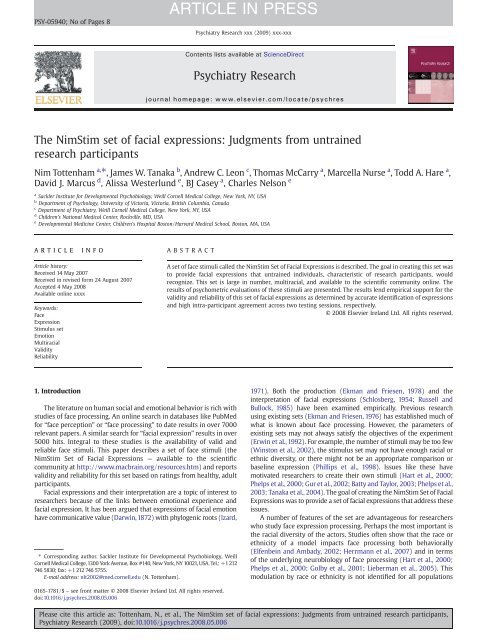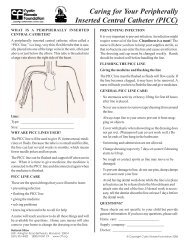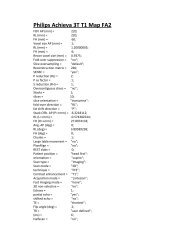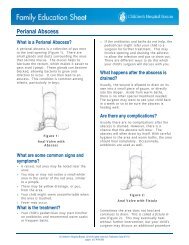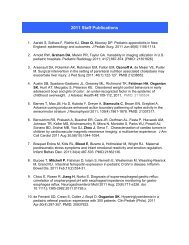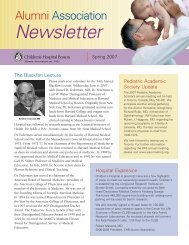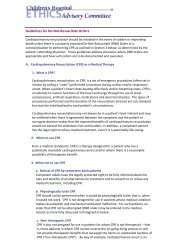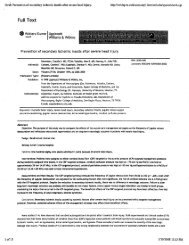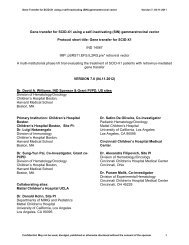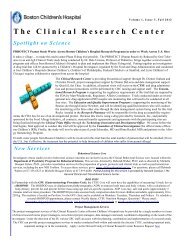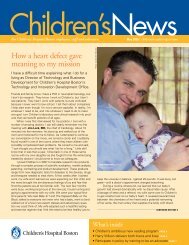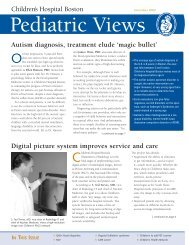The NimStim set of facial expressions - Children's Hospital Boston
The NimStim set of facial expressions - Children's Hospital Boston
The NimStim set of facial expressions - Children's Hospital Boston
You also want an ePaper? Increase the reach of your titles
YUMPU automatically turns print PDFs into web optimized ePapers that Google loves.
PSY-05940; No <strong>of</strong> Pages 8<br />
<strong>The</strong> <strong>NimStim</strong> <strong>set</strong> <strong>of</strong> <strong>facial</strong> <strong>expressions</strong>: Judgments from untrained<br />
research participants<br />
Nim Tottenham a, ⁎, James W. Tanaka b , Andrew C. Leon c , Thomas McCarry a , Marcella Nurse a , Todd A. Hare a ,<br />
David J. Marcus d , Alissa Westerlund e , BJ Casey a , Charles Nelson e<br />
a<br />
Sackler Institute for Developmental Psychobiology, Weill Cornell Medical College, New York, NY, USA<br />
b<br />
Department <strong>of</strong> Psychology, University <strong>of</strong> Victoria, Victoria, British Columbia, Canada<br />
c<br />
Department <strong>of</strong> Psychiatry, Weill Cornell Medical College, New York, NY, USA<br />
d<br />
<strong>Children's</strong> National Medical Center, Rockville, MD, USA<br />
e<br />
Developmental Medicine Center, <strong>Children's</strong> <strong>Hospital</strong> <strong>Boston</strong>/Harvard Medical School, <strong>Boston</strong>, MA, USA<br />
ARTICLE INFO<br />
Article history:<br />
Received 14 May 2007<br />
Received in revised form 24 August 2007<br />
Accepted 4 May 2008<br />
Available online xxxx<br />
Keywords:<br />
Face<br />
Expression<br />
Stimulus <strong>set</strong><br />
Emotion<br />
Multiracial<br />
Validity<br />
Reliability<br />
1. Introduction<br />
ABSTRACT<br />
<strong>The</strong> literature on human social and emotional behavior is rich with<br />
studies <strong>of</strong> face processing. An online search in databases like PubMed<br />
for “face perception” or “face processing” to date results in over 7000<br />
relevant papers. A similar search for “<strong>facial</strong> expression” results in over<br />
5000 hits. Integral to these studies is the availability <strong>of</strong> valid and<br />
reliable face stimuli. This paper describes a <strong>set</strong> <strong>of</strong> face stimuli (the<br />
<strong>NimStim</strong> Set <strong>of</strong> Facial Expressions — available to the scientific<br />
community at http://www.macbrain.org/resources.htm) and reports<br />
validity and reliability for this <strong>set</strong> based on ratings from healthy, adult<br />
participants.<br />
Facial <strong>expressions</strong> and their interpretation are a topic <strong>of</strong> interest to<br />
researchers because <strong>of</strong> the links between emotional experience and<br />
<strong>facial</strong> expression. It has been argued that <strong>expressions</strong> <strong>of</strong> <strong>facial</strong> emotion<br />
have communicative value (Darwin,1872) with phylogenic roots (lzard,<br />
⁎ Corresponding author. Sackler Institute for Developmental Psychobiology, Weill<br />
Cornell Medical College, 1300 York Avenue, Box #140, New York, NY 10021, USA. Tel.: +1 212<br />
746 5830; fax: +1 212 746 5755.<br />
E-mail address: nlt2002@med.cornell.edu (N. Tottenham).<br />
0165-1781/$ – see front matter © 2008 Elsevier Ireland Ltd. All rights reserved.<br />
doi:10.1016/j.psychres.2008.05.006<br />
ARTICLE IN PRESS<br />
Psychiatry Research xxx (2009) xxx-xxx<br />
Contents lists available at ScienceDirect<br />
Psychiatry Research<br />
journal homepage: www.elsevier.com/locate/psychres<br />
A <strong>set</strong> <strong>of</strong> face stimuli called the <strong>NimStim</strong> Set <strong>of</strong> Facial Expressions is described. <strong>The</strong> goal in creating this <strong>set</strong> was<br />
to provide <strong>facial</strong> <strong>expressions</strong> that untrained individuals, characteristic <strong>of</strong> research participants, would<br />
recognize. This <strong>set</strong> is large in number, multiracial, and available to the scientific community online. <strong>The</strong><br />
results <strong>of</strong> psychometric evaluations <strong>of</strong> these stimuli are presented. <strong>The</strong> results lend empirical support for the<br />
validity and reliability <strong>of</strong> this <strong>set</strong> <strong>of</strong> <strong>facial</strong> <strong>expressions</strong> as determined by accurate identification <strong>of</strong> <strong>expressions</strong><br />
and high intra-participant agreement across two testing sessions, respectively.<br />
© 2008 Elsevier Ireland Ltd. All rights reserved.<br />
1971). Both the production (Ekman and Friesen, 1978) and the<br />
interpretation <strong>of</strong> <strong>facial</strong> <strong>expressions</strong> (Schlosberg, 1954; Russell and<br />
Bullock, 1985) have been examined empirically. Previous research<br />
using existing <strong>set</strong>s (Ekman and Friesen, 1976) hasestablishedmuch<strong>of</strong><br />
what is known about face processing. However, the parameters <strong>of</strong><br />
existing <strong>set</strong>s may not always satisfy the objectives <strong>of</strong> the experiment<br />
(Erwin et al., 1992). For example, the number <strong>of</strong> stimuli may be too few<br />
(Winston et al., 2002), the stimulus <strong>set</strong> may not have enough racial or<br />
ethnic diversity, or there might not be an appropriate comparison or<br />
baseline expression (Phillips et al., 1998). Issues like these have<br />
motivated researchers to create their own stimuli (Hart et al., 2000;<br />
Phelps et al., 2000; Gur et al., 2002; Batty and Taylor, 2003; Phelps et al.,<br />
2003; Tanaka et al., 2004). <strong>The</strong> goal <strong>of</strong> creating the <strong>NimStim</strong> Set <strong>of</strong> Facial<br />
Expressions was to provide a <strong>set</strong> <strong>of</strong> <strong>facial</strong> <strong>expressions</strong> that address these<br />
issues.<br />
A number <strong>of</strong> features <strong>of</strong> the <strong>set</strong> are advantageous for researchers<br />
who study face expression processing. Perhaps the most important is<br />
the racial diversity <strong>of</strong> the actors. Studies <strong>of</strong>ten show that the race or<br />
ethnicity <strong>of</strong> a model impacts face processing both behaviorally<br />
(Elfenbein and Ambady, 2002; Herrmann et al., 2007) and in terms<br />
<strong>of</strong> the underlying neurobiology <strong>of</strong> face processing (Hart et al., 2000;<br />
Phelps et al., 2000; Golby et al., 2001; Lieberman et al., 2005). This<br />
modulation by race or ethnicity is not identified for all populations<br />
Please cite this article as: Tottenham, N., et al., <strong>The</strong> <strong>NimStim</strong> <strong>set</strong> <strong>of</strong> <strong>facial</strong> <strong>expressions</strong>: Judgments from untrained research participants,<br />
Psychiatry Research (2009), doi:10.1016/j.psychres.2008.05.006
(Beaupre and Hess, 2005) and may be driven by experience (Elfenbein<br />
and Ambady, 2003) and bias (Phelps et al., 2000; Hugenberg and<br />
Bodenhausen, 2003).<br />
To address such findings, face <strong>set</strong>s have been developed that<br />
consist <strong>of</strong> models from various backgrounds. For example, the JACFEE<br />
<strong>set</strong> (Ekman and Matsumoto, 1993–2004) consists <strong>of</strong> Japanese and<br />
Caucasian models, Mandal's (1987) <strong>set</strong> consists <strong>of</strong> Indian models,<br />
Mandal et al.'s (2001) <strong>set</strong> consists <strong>of</strong> Japanese models, the Montreal<br />
Set <strong>of</strong> Facial Displays <strong>of</strong> Emotion (Beaupre et al., 2000) consists <strong>of</strong><br />
French Canadian, Chinese, and sub-Saharan African models, and Wang<br />
and Markham's (1999) <strong>set</strong> consists <strong>of</strong> Chinese models. Unlike these<br />
other <strong>set</strong>s, the <strong>NimStim</strong> <strong>set</strong> provides one uniform <strong>set</strong> <strong>of</strong> Asian-<br />
American, African-American, European-American, and Latino-American<br />
actors, all photographed under identical conditions. Additionally,<br />
because these actors all live in the same metropolitan city within the<br />
U.S., the subtle differences that accompany <strong>expressions</strong> when posed<br />
by individuals from different countries are minimized (Ekman and<br />
Friesen, 1969; Matsumoto et al., 2005). <strong>The</strong> <strong>NimStim</strong> <strong>set</strong> has attributes,<br />
described below, that are not typically found in other <strong>set</strong>s that include<br />
models from non-European populations.<br />
<strong>The</strong>re are four distinguishing attributes <strong>of</strong> the <strong>set</strong> that build on<br />
previously established <strong>set</strong>s. First, the <strong>NimStim</strong> <strong>set</strong> is available in color,<br />
and it contains a large number <strong>of</strong> stimuli and a large variety <strong>of</strong> <strong>facial</strong><br />
<strong>expressions</strong>. Whereas most <strong>set</strong>s contain roughly 100 or fewer stimuli<br />
(Mandal, 1987; Ekman and Matsumoto, 1993–2004; Wang and Markham,<br />
1999; Mandal et al., 2001), the <strong>NimStim</strong> <strong>set</strong> contains 672,<br />
consisting <strong>of</strong> 43 pr<strong>of</strong>essional actors, each modeling 16 different <strong>facial</strong><br />
poses, including different examples <strong>of</strong> happy, sad, disgusted, fearful,<br />
angry, surprised, neutral, and calm. Secondly, a neutral expression is<br />
included in this <strong>set</strong>. <strong>The</strong> neutral expression is sometimes included in<br />
other <strong>facial</strong> expression <strong>set</strong>s (Ekman and Friesen,1976; Erwin et al.,1992;<br />
Ekman and Matsumoto,1993–2004), but is <strong>of</strong>ten omitted, particularly in<br />
<strong>set</strong>s that include models from different racial and ethnic backgrounds<br />
(Mandal,1987; Wang and Markham,1999; Beaupre et al., 2000; Mandal<br />
et al., 2001). <strong>The</strong> inclusion <strong>of</strong> the neutral expression is important since<br />
neutral is <strong>of</strong>ten a comparison condition, particularly in neuroimaging<br />
studies (Breiter et al., 1996; Thomas et al., 2001). Thirdly, the <strong>NimStim</strong><br />
<strong>set</strong> contains open- and closed-mouth versions <strong>of</strong> each expression, which<br />
can be useful to experimentally control for perceptual differences (e.g.,<br />
toothiness) that can vary from one expression to another, as this featural<br />
difference may bias responses (Kestenbaum and Nelson, 1990). Having<br />
closed- and open-mouth versions also facilitates morphing between<br />
various <strong>expressions</strong> by reducing blending artifacts. Lastly, since<br />
positively valenced faces are generally lower in arousal than negatively<br />
valenced faces and can present an arousal/valence confound, this <strong>set</strong><br />
includes three degrees <strong>of</strong> happy faces (e.g., closed-mouth, open-mouth,<br />
and high arousal/exuberant).<br />
A final distinguishing feature <strong>of</strong> this <strong>set</strong> is the inclusion <strong>of</strong> a calm<br />
face. Studies examining the perception <strong>of</strong> <strong>facial</strong> <strong>expressions</strong> <strong>of</strong>ten use<br />
neutral faces as the comparison face (Breiter et al., 1996; Vuilleumier<br />
et al., 2001). However, there is evidence to suggest that neutral faces<br />
may not always be perceived as emotionally neutral (Donegan et al.,<br />
2003; Somerville et al., 2004; Iidaka et al., 2005), especially for<br />
children (Thomas et al., 2001; Lobaugh et al., 2006). Researchers have<br />
artificially generated other comparison faces (i.e., 25% happy) to<br />
address this concern (Phillips et al., 1997). Within the <strong>NimStim</strong> Set, a<br />
calm expression category is provided, which is perceptually similar to<br />
neutral, but may be perceived as having a less negative valence. Here<br />
we provide data validating the use <strong>of</strong> the calm face.<br />
Validation <strong>of</strong> the entire <strong>set</strong> was accomplished by asking participants<br />
to label each stimulus. A different method <strong>of</strong> rating face stimuli<br />
involves having highly trained raters use <strong>facial</strong> action units to make<br />
judgments about the <strong>expressions</strong> (Ekman and Friesen, 1977; Ekman<br />
and Friesen, 1978). This method is very useful for establishing the<br />
uniformity <strong>of</strong> expression exemplars. <strong>The</strong> merit <strong>of</strong> the method used in<br />
this article is that the ratings were obtained from untrained<br />
ARTICLE IN PRESS<br />
2 N. Tottenham et al. / Psychiatry Research xxx (2009) xxx-xxx<br />
volunteers, who are characteristic <strong>of</strong> those in face expression<br />
processing studies. In other words, the approach taken in this study<br />
to establish whether a certain expression was perceived as the<br />
intended expression was to measure concordance between the<br />
subjects' labels and the intended <strong>expressions</strong> posed by the actors<br />
(the validity measure) as well as the intra-participant test–retest<br />
reliability. We hypothesized that the participants' judgments <strong>of</strong> these<br />
stimuli would provide empirical support for the reliability and validity<br />
<strong>of</strong> this new <strong>set</strong> <strong>of</strong> <strong>facial</strong> <strong>expressions</strong>.<br />
2. Method<br />
2.1. Participants<br />
Data were collected from two groups <strong>of</strong> participants, producing a<br />
total N <strong>of</strong> 81 participants. <strong>The</strong> first group included 47 undergraduate<br />
students from a liberal arts college located in the Midwestern United<br />
States. Mean age was 19.4 years (18–22, S.D.=1.2), and the majority<br />
(39/47) <strong>of</strong> these respondents were female. <strong>The</strong> participants received<br />
course credit for their participation in the study. Based on the<br />
participant pool data, it was estimated that 81% (38/47) were<br />
European-American, 6% (3/47) were African-American, 9% (4/47)<br />
were Asian-American, and 4% (2/47) were Hispanic-American. Only<br />
validity ratings, not reliability ratings, were obtained from this first<br />
group <strong>of</strong> participants. In order to increase the number <strong>of</strong> participants<br />
for the validity ratings, in particular, male participants, we recruited a<br />
second group <strong>of</strong> participants, which comprised 34 volunteers from<br />
the New York Metropolitan area. Mean age <strong>of</strong> this group was<br />
25.8 years (19–35, S.D. = 4.1), and 35% (12/34) were female and<br />
65% (22/34) were male. <strong>The</strong> participants were monetarily compensated<br />
for their time. Fifty-nine percent (20/34) were European-<br />
American, 18% (6/34) were African-American, 6% (2/34) were Asian-<br />
American, 6% (2/34) were Latino-American, and 12% (4/34)<br />
identified as a non-listed race or ethnicity. Three measures were<br />
obtained from this second group <strong>of</strong> participants: validity, test–retest<br />
reliability, and calm vs. neutral validity.<br />
2.2. Stimuli<br />
Stimuli were images from the <strong>NimStim</strong> Set <strong>of</strong> Facial Expressions<br />
(672 images; http://www.macbrain.org/resources.htm), which consisted<br />
<strong>of</strong> naturally posed photographs (e.g., with hair, make-up) <strong>of</strong> 43<br />
pr<strong>of</strong>essional actors (18 female, 25 male; 21 years old–30 years old) in<br />
New York City. Actors were African- (N =10), Asian- (N =6),<br />
European- (N =25), and Latino-American (N = 2). Actors were<br />
instructed to pose eight <strong>expressions</strong>: happy, sad, angry, fearful,<br />
surprised, disgusted, neutral, and calm (see Fig. 1). For each<br />
expression, separate open- and closed-mouth versions were posed,<br />
except for surprise, which were only posed with an open mouth 1 .<br />
Negatively valenced faces typically differ from faces like happy in<br />
terms <strong>of</strong> valence, but also are higher in arousal level. <strong>The</strong>refore, three<br />
versions <strong>of</strong> happy were obtained (closed-mouth, open-mouth, and<br />
high arousal open-mouth/exuberant). All stimuli were included in<br />
this validation paradigm regardless <strong>of</strong> the quality <strong>of</strong> acting.<br />
Actors were instructed to pose a particular expression (e.g., “Make<br />
a happy face”) and produce the <strong>facial</strong> expression as they saw fit<br />
(Mandal, 1987; Mandal et al., 2001). Once one version <strong>of</strong> the <strong>facial</strong><br />
expression (e.g., closed mouth) was created and photographed, the<br />
other version (e.g., open mouth) was prompted and photographed. To<br />
create the calm faces, actors were instructed to transfigure their<br />
neutral face into a more relaxed one, as if they were engaged in a<br />
calming activity or otherwise pleasantly preoccupied. <strong>The</strong>refore, the<br />
1 A closed-mouth version <strong>of</strong> surprise is modeled by two <strong>of</strong> the actors.<br />
Please cite this article as: Tottenham, N., et al., <strong>The</strong> <strong>NimStim</strong> <strong>set</strong> <strong>of</strong> <strong>facial</strong> <strong>expressions</strong>: Judgments from untrained research participants,<br />
Psychiatry Research (2009), doi:10.1016/j.psychres.2008.05.006
calm faces were essentially neutral faces with less overall muscle<br />
tension in the face. Actors were paid for their time.<br />
2.3. Evaluation procedure<br />
2.3.1. Validity<br />
Participants were seated approximately 53 cm from the computer.<br />
All 672 stimuli were presented on a Macintosh computer using the<br />
Psyscope experimental s<strong>of</strong>tware package (Cohen et al., 1993). Images<br />
were presented in 256-bit color at a vertical visual angle <strong>of</strong> 9.11° and a<br />
horizontal angle <strong>of</strong> 7°. On each trial, a face was presented with the<br />
choices “angry”, “surprise”, “afraid”, “sad”, “happy”, “disgust”, “neutral”,<br />
“calm”,and“none <strong>of</strong> the above”. <strong>The</strong> participant's task was to label each<br />
image or indicate that none <strong>of</strong> the labels were appropriate (i.e., “none <strong>of</strong><br />
the above”). Stimuli were presented randomly in a different order for<br />
each participant, and participants proceeded at their own pace.<br />
2.3.2. Reliability<br />
After an approximately 20-minute break following the first<br />
presentation <strong>of</strong> the stimuli, participants rated all <strong>of</strong> the 672 face<br />
stimuli for a second time using the same procedure described above<br />
for the validity ratings. Stimuli were presented in a different random<br />
order than the first presentation. Judgments made during this second<br />
presentation were not included in the validity scores.<br />
2.3.3. Calm vs. neutral validity ratings<br />
During the break between ratings <strong>of</strong> the <strong>set</strong> for the first and second<br />
time, participants rated calm and neutral faces, which were presented<br />
side by side, with one model posing each face per slide. <strong>The</strong> images<br />
were presented at a visual vertical angle <strong>of</strong> 14.8° and horizontal angle<br />
ARTICLE IN PRESS<br />
N. Tottenham et al. / Psychiatry Research xxx (2009) xxx-xxx<br />
Fig. 1. Examples <strong>of</strong> the 16 <strong>expressions</strong> posed by actors.<br />
<strong>of</strong> 10.7° and presented grayscale 2 . <strong>The</strong>se calm and neutral faces were<br />
the same ones included in the judgments <strong>of</strong> the entire <strong>set</strong> (i.e., when<br />
validity and reliability ratings were obtained). Participants were<br />
provided with these definitions and asked to label each face as calm,<br />
neutral, or neither:<br />
NEUTRAL: plain, alert face, like passport photo. Neither negative<br />
nor positive.<br />
CALM: similar to neutral, almost bordering on pleased, or slightly<br />
happy — maybe daydreaming. Person looks very serene, less<br />
threatening than neutral.<br />
2.4. Data analytic procedures<br />
2.4.1. Validity<br />
Validity ratings were collected from the two groups <strong>of</strong> participants,<br />
and these ratings did not differ from each other for both proportion<br />
correct and kappa scores (see Supplemental Table 1a and 1b);<br />
therefore, their data were combined 3 . <strong>The</strong>se validity scores were<br />
calculated from the first presentation <strong>of</strong> the 672 stimuli. Evaluations <strong>of</strong><br />
<strong>facial</strong> expression <strong>set</strong>s typically rely on percent correct (i.e., proportion<br />
<strong>of</strong> participants who agree with intended expression) as the dependent<br />
2 Although calm and neutral face stimuli are available in color, calm and neutral<br />
validity ratings were obtained using grayscale stimuli because validity <strong>of</strong> these two<br />
stimulus types needed to be established as part <strong>of</strong> a different protocol that used<br />
grayscale images.<br />
3 <strong>The</strong> first group <strong>of</strong> participants did not rate stimuli from model #45 whose<br />
photographs were obtained after the first group was recruited.<br />
Please cite this article as: Tottenham, N., et al., <strong>The</strong> <strong>NimStim</strong> <strong>set</strong> <strong>of</strong> <strong>facial</strong> <strong>expressions</strong>: Judgments from untrained research participants,<br />
Psychiatry Research (2009), doi:10.1016/j.psychres.2008.05.006<br />
3
variable (Ekman and Friesen, 1976; Mandal, 1987; Biehl et al., 1997;<br />
Wang and Markham, 1999; Mandal et al., 2001; Beaupre and Hess,<br />
2005). However, this type <strong>of</strong> statistic does not account for false<br />
positives (Erwin et al., 1992). Although proportion correct is reported<br />
here, we also report Cohen's kappa (Cohen, 1960), which is a chancecorrected<br />
measure <strong>of</strong> agreement between the intended expression and<br />
the participants' labels. <strong>The</strong>re were 672 stimuli resulting in 672 kappas.<br />
<strong>The</strong>se kappas were calculated to estimate concordance between the<br />
labels and the intended expression for each stimulus, examined within<br />
actor, separately for open- and closed-mouth conditions 4 . Since the<br />
‘none <strong>of</strong> the above” option was provided, this choice was considered<br />
incorrect in the kappa calculation just as other incorrect emotion labels<br />
were. Lastly, it was not anticipated that calm and neutral would be<br />
identified as two separate <strong>expressions</strong> during this labeling task since<br />
the perceptual differences between the faces are quite small relative to<br />
the differences between the other <strong>expressions</strong> tested. <strong>The</strong>refore,<br />
responses <strong>of</strong> “calm” or “neutral” were accepted as correct for both<br />
calm and neutral <strong>facial</strong> <strong>expressions</strong>.<br />
2.4.2. Reliability<br />
Because <strong>of</strong> the high test–retest reliability for most <strong>of</strong> the stimuli,<br />
calculating kappa was <strong>of</strong>ten mathematically intractable and did not<br />
appropriately reflect the concordance <strong>of</strong> ratings over time 5 . <strong>The</strong>refore,<br />
proportion agreement between the first and second ratings was used<br />
to quantify extent <strong>of</strong> reliability <strong>of</strong> each face stimulus.<br />
2.4.3. Validity <strong>of</strong> calm and neutral<br />
As with the validity ratings <strong>of</strong> the entire data <strong>set</strong>, we calculated<br />
proportion correct and kappas for each calm and neutral stimulus to<br />
estimate the concordance between emotion label (either “calm”,<br />
“neutral”, or“neither”) and intended expression within each actor.<br />
<strong>The</strong> answer “neither” was also counted as an incorrect response.<br />
3. Results<br />
3.1. Validity<br />
<strong>The</strong>re were two validity measures (proportion correct and kappa<br />
scores) for each stimulus, thus resulting in 672 proportion correct and<br />
kappa scores. <strong>The</strong>se 672 proportion correct and kappa scores are<br />
presented individually in Supplemental Tables 2a and 2b and in<br />
aggregate by actor (43 actors×2 mouth positions=86 scores) in<br />
Supplemental Table 3, but by expression (17 scores) for succinctness<br />
within this manuscript (Table 1; closed and open mouth separately).<br />
<strong>The</strong> overall proportion correct was high (mean=0.81 (S.D.=0.19),<br />
median=0.88). <strong>The</strong> overall concordance between raters' labels and<br />
the intended <strong>expressions</strong> was also high (mean kappa across<br />
stimuli=0.79 (S.D.=0.17); median kappa=0.83). Table 2 presents<br />
the confusion matrix for the labels chosen by participants, which<br />
represents the average proportion <strong>of</strong> target and non-target labels<br />
endorsed for each expression and shows that errors were fairly<br />
consistent for each expression (e.g., incorrect judgments for fear faces<br />
were usually mislabeled as “surprise”).<br />
4 <strong>The</strong>se calculations involved separate 2× 2 contingency tables for each intended<br />
emotion in which the accuracy <strong>of</strong> the ratings was cross-classified with intended<br />
emotion, examined at the level <strong>of</strong> actor. For instance, a stimulus was either fear or a<br />
non-fear face (e.g., happy, sad, surprise). Likewise, the corresponding label <strong>of</strong> that stimulus<br />
provided by the raters was either “fear” or not. All ratings (approximately 567 for the<br />
closed-mouth <strong>expressions</strong> (81 raters×7 <strong>expressions</strong>) and 729 for the open-mouth<br />
<strong>expressions</strong> (81 raters×9 <strong>expressions</strong>)) were used in each validity contingency table.<br />
5 <strong>The</strong> reliability paradigm resulted in quite limited variability in the cells <strong>of</strong> the<br />
contingency table (i.e., as a group, subjects rated faces nearly identically in the two<br />
sessions, resulting in very high agreement). Kappa is not appropriate for certain cases<br />
such as when there is very low (or very high) prevalence <strong>of</strong> events (Kraemer et al.,<br />
2002. Tutorial in biostatistics: Kappa coefficients in medical research. Statistics in<br />
Medicine 21, 2109–2129).<br />
ARTICLE IN PRESS<br />
4 N. Tottenham et al. / Psychiatry Research xxx (2009) xxx-xxx<br />
Table 1<br />
Description <strong>of</strong> validity ratings for individual emotional <strong>expressions</strong> (N=81 subjects<br />
rating 672 stimuli).<br />
Validity ratings were similar from one actor to another. Forty-five<br />
percent (39/86) <strong>of</strong> the kappas calculated per actor ranged from 0.8 to<br />
1.0, a range considered to reflect almost perfect concordance between<br />
the given label and intended expression by Landis and Koch (1977),and<br />
the corresponding mean proportion correct scores ranged from 0.81 to<br />
0.93. <strong>The</strong> remaining 55% (47/86) <strong>of</strong> these kappas ranged from 0.59 and<br />
0.79, and the mean proportion correct scores ranged from 0.67 to 0.84.<br />
<strong>The</strong>re were differences in proportion correct (F(15, 435)=24.65,<br />
Pb0.0001)andkappascores(F(15, 435)=28.65, Pb0.0001) from one<br />
emotional expression to another indicating that some emotions were<br />
more accurately identified than others. Approximately half (8/17) <strong>of</strong> the<br />
mean kappas for emotional expression were above a 0.8 kappa cut point.<br />
<strong>The</strong> <strong>expressions</strong> above this threshold included happy (open), happy<br />
(closed), angry (open), happy (open exuberant), neutral (closed), calm<br />
(closed), neutral (open), and calm (open), and these <strong>expressions</strong> had<br />
mean proportion correct scores that ranged between 0.79 and 0.98.<br />
Another 47% (8/17) <strong>of</strong> the <strong>expressions</strong> had mean kappas between 0.6 and<br />
0.79. <strong>The</strong>se <strong>expressions</strong> included angry (closed), disgust (open), sad<br />
(closed), disgust (closed), surprised (open), fear (open), sad (open), and<br />
surprised (closed), and these <strong>expressions</strong> had mean proportion correct<br />
scores that ranged from 0.61 to 0.84. <strong>The</strong> fear (closed) expression had a<br />
mean kappa <strong>of</strong> 0.54 and a mean proportion correct score <strong>of</strong> 0.47. Table 3<br />
shows the descriptive and inferential statistics that compare the open- and<br />
closed-mouth versions <strong>of</strong> <strong>expressions</strong>. <strong>The</strong>se calculations show that<br />
<strong>expressions</strong> were not identified equally for open and closed versions.<br />
Angry, fear, and happy faces resulted in higher kappa scores with open<br />
mouths, whereas sad was more accurately identified with a closed mouth.<br />
3.2. Reliability<br />
Median proportion<br />
correct<br />
Mean (S.D.)<br />
proportion correct<br />
Median<br />
kappa<br />
Mean (S.D.)<br />
kappa<br />
Angry (closed) 0.90 0.84 (0.17) 0.81 0.78 (0.13)<br />
Calm (closed) 0.90 0.88 (0.07) 0.87 0.84 (0.09)<br />
Disgust (closed) 0.86 0.76 (0.23) 0.83 0.75 (0.19)<br />
Fear (closed) 0.51 0.47 (0.21) 0.58 0.54 (0.20)<br />
Happy (closed) 0.94 0.92 (0.07) 0.94 0.92 (0.06)<br />
Neutral (closed) 0.93 0.91 (0.06) 0.87 0.86 (0.08)<br />
Sad (closed) 0.91 0.83 (0.16) 0.76 0.76 (0.13)<br />
Surprised<br />
(closed)<br />
0.61 0.61 (0.10) 0.62 0.62 (0.08)<br />
Angry (open) 0.96 0.90 (0.15) 0.92 0.88 (0.11)<br />
Calm (open) 0.81 0.79 (0.11) 0.84 0.81 (0.10)<br />
Disgust (open) 0.93 0.84 (0.21) 0.82 0.77 (0.18)<br />
Fear (open) 0.74 0.73 (0.12) 0.69 0.67 (0.12)<br />
Happy (open) 0.99 0.98 (0.02) 0.97 0.95 (0.05)<br />
Neutral (open) 0.86 0.82 (0.11) 0.86 0.83 (0.09)<br />
Sad (open) 0.59 0.60 (0.21) 0.64 0.62 (0.18)<br />
Surprised (open) 0.86 0.81 (0.13) 0.68 0.68 (0.12)<br />
Happy<br />
(open exuberant)<br />
0.88 0.86 (0.13) 0.90 0.88 (0.09)<br />
Reliability scores (i.e., proportion agreement) were calculated for<br />
each stimulus to quantify agreement between times 1 and 2 for each<br />
stimulus, and these values for individual stimuli can be found in<br />
Supplemental Table 4. To show the data in a succinct fashion, results are<br />
presented in aggregate for each expression (Table 4;closedandopen<br />
mouth separately). Overall, there was agreement between times 1 and 2,<br />
with a mean (S.D.) reliability score <strong>of</strong> 0.84 (0.08) and median <strong>of</strong> 0.86.<br />
<strong>The</strong>re was little variability in reliability scores from one actor to<br />
another (closed mouth and open mouth calculated separately).<br />
Ninety-one percent (78/86) <strong>of</strong> the actors had mean reliability scores<br />
that ranged between 0.80 and 1.00. <strong>The</strong> remaining 9% was between<br />
0.73 and 0.79. In contrast, the mean reliability scores for each<br />
emotional expression indicate that some emotions were more reliably<br />
Please cite this article as: Tottenham, N., et al., <strong>The</strong> <strong>NimStim</strong> <strong>set</strong> <strong>of</strong> <strong>facial</strong> <strong>expressions</strong>: Judgments from untrained research participants,<br />
Psychiatry Research (2009), doi:10.1016/j.psychres.2008.05.006
Table 2<br />
Confusion matrix for mean (S.D.) proportion <strong>of</strong> subjects who endorsed each emotion label.<br />
identified than others (see Table 4). <strong>The</strong> majority (13/17) <strong>of</strong><br />
<strong>expressions</strong> had average reliability scores that ranged between 0.80<br />
and 1.00, and the remaining 24% ranged between 0.68 and 0.77.<br />
3.3. Calm and neutral validity<br />
Eighty-six proportion correct scores and kappas were calculated<br />
for the calm and neutral stimuli, one for each calm or neutral<br />
stimulus (see Table 5). Scores varied considerably from one actor to<br />
another indicating that some actors expressed calm and neutral<br />
faces better than others. Mean proportion correct for neutral faces<br />
was 0.72 (S.D. = 0.18; range: 0.12–0.91), median proportion correct<br />
was 0.76, mean kappa was 0.34 (S.D.=0.39; range: −0.65–0.88),<br />
and median kappa was 0.38. Mean proportion correct for calm faces<br />
was 0.56 (S.D. = 0.27; range: 0.09–0.91), median proportion correct<br />
was 0.62, mean kappa was 0.32 (S.D.= 0.40; range: −0.65–0.88),<br />
and median kappa was 0.38. Nearly half <strong>of</strong> the neutral faces (21/43)<br />
and half <strong>of</strong> the calm faces (21/43) had kappas that exceeded 0.40,<br />
and these faces had a mean proportion correct <strong>of</strong> 0.82 and 0.79,<br />
respectively. <strong>The</strong> proportion correct scores for calm and neutral<br />
faces are positively correlated (r(41) =0.69, P b0.001), indicating<br />
that a model who posed an identifiable neutral face was also likely to<br />
pose an identifiable calm face.<br />
4. Discussion<br />
Label<br />
Photograph Angry Calm/neutral Disgust Fear Happy Sad Surprised Nothing N<br />
Angry (closed) 0.84 (0.17) 0.03 (0.07) 0.05 (0.09) 0.01 (0.02) 0.00 (0.01) 0.05 (0.08) 0.00 (0.01) 0.01 (0.02) 78.93 (7.22)<br />
Angry (open) 0.90 (0.15) 0.00 (0.01) 0.05 (0.09) 0.02 (0.05) 0.00 (0.01) 0.01 (0.02) 0.00 (0.01) 0.01 (0.02) 79.07 (7.27)<br />
Calm (closed) 0.02 (0.03) 0.88 (0.07) 0.00 (0.01) 0.01 (0.01) 0.02 (0.05) 0.02 (0.05) 0.00 (0.01) 0.02 (0.02) 79.33 (7.36)<br />
Calm (open) 0.01 (0.02) 0.79 (0.11) 0.02 (0.02) 0.03 (0.05) 0.01 (0.04) 0.03 (0.05) 0.05 (0.05) 0.05 (0.04) 78.95 (7.31)<br />
Disgust (closed) 0.13 (0.18) 0.01 (0.01) 0.76 (0.23) 0.01 (0.01) 0.00 (0.01) 0.08 (0.17) 0.00 (0.01) 0.01 (0.02) 79.15 (7.47)<br />
Disgust (open) 0.03 (0.04) 0.00 (0.01) 0.84 (0.21) 0.02 (0.03) 0.00 (0.01) 0.09 (0.20) 0.01 (0.02) 0.01 (0.02) 79.14 (7.11)<br />
Fear (closed) 0.03 (0.06) 0.04 (0.06) 0.04 (0.08) 0.47 (0.21) 0.01 (0.01) 0.10 (0.16) 0.29 (0.20) 0.02 (0.02) 78.92 (7.76)<br />
Fear (open) 0.02 (0.05) 0.00 (0.01) 0.02 (0.03) 0.73 (0.12) 0.01 (0.01) 0.01 (0.03) 0.19 (0.12) 0.01 (0.01) 79.37 (7.13)<br />
Happy (closed) 0.00 (0.01) 0.06 (0.06) 0.00 (0.01) 0.00 (0.00) 0.92 (0.07) 0.00 (0.01) 0.00 (0.01) 0.00 (0.01) 79.31 (7.21)<br />
Happy (open) 0.00 (0.01) 0.01 (0.02) 0.00 (0.00) 0.00 (0.00) 0.98 (0.02) 0.00 (0.00) 0.00 (0.00) 0.00 (0.01) 79.47 (7.13)<br />
Happy (open exuberant) 0.00 (0.00) 0.00 (0.00) 0.00 (0.00) 0.01 (0.01) 0.86 (0.13) 0.00 (0.00) 0.13 (0.12) 0.00 (0.01) 79.31 (7.20)<br />
Neutral (closed) 0.02 (0.03) 0.91 (0.06) 0.00 (0.01) 0.01 (0.01) 0.01 (0.01) 0.03 (0.05) 0.00 (0.01) 0.02 (0.02) 79.35 (7.12)<br />
Neutral (open) 0.02 (0.02) 0.82 (0.11) 0.01 (0.02) 0.04 (0.05) 0.01 (0.01) 0.03 (0.05) 0.05 (0.05) 0.03 (0.02) 79.14 (7.34)<br />
Sad (closed) 0.03 (0.05) 0.04 (0.06) 0.04 (0.07) 0.03 (0.07) 0.00 (0.01) 0.83 (0.16) 0.01 (0.04) 0.02 (0.02) 79.05 (7.17)<br />
Sad (open) 0.02 (0.04) 0.07 (0.13) 0.15 (0.14) 0.09 (0.10) 0.00 (0.01) 0.60 (0.21) 0.03 (0.03) 0.03 (0.03) 79.10 (7.33)<br />
Surprised (closed) 0.00 (0.00) 0.12 (0.05) 0.00 (0.00) 0.18 (0.06) 0.06 (0.08) 0.01 (0.01) 0.61 (0.10) 0.02 (0.02) 80.50 (0.71)<br />
Surprised (open) 0.00 (0.00) 0.01 (0.00) 0.00 (0.01) 0.14 (0.13) 0.03 (0.07) 0.00 (0.00) 0.81 (0.13) 0.00 (0.01) 79.35 (7.11)<br />
Target emotion in bold.<br />
<strong>The</strong> purpose <strong>of</strong> this article was to present a <strong>set</strong> <strong>of</strong> <strong>facial</strong> expression<br />
stimuli and to present data describing the judgments <strong>of</strong> these stimuli<br />
Table 3<br />
Comparing closed and opened mouth versions <strong>of</strong> five basic emotional <strong>expressions</strong>.<br />
Closed mean Open mean t Df Sig. (2-tailed)<br />
Kappa<br />
Angry 0.78 0.88 −4.60 42 0.00<br />
Disgust 0.75 0.76 −0.25 38 0.80<br />
Fear 0.54 0.67 −4.12 35 0.00<br />
Happy 0.92 0.95 −3.13 41 0.00<br />
Sad<br />
Proportion correct<br />
0.76 0.63 4.25 40 0.00<br />
Angry 0.84 0.90 −1.90 42 0.06<br />
Disgust 0.76 0.84 −1.73 38 0.09<br />
Fear 0.47 0.73 −7.47 35 0.00<br />
Happy 0.92 0.98 −5.08 41 0.00<br />
Sad 0.83 0.60 6.85 40 0.00<br />
ARTICLE IN PRESS<br />
N. Tottenham et al. / Psychiatry Research xxx (2009) xxx-xxx<br />
by untrained, healthy adult research participants. This face <strong>set</strong> is large<br />
in number, is multiracial, has contemporary looking, pr<strong>of</strong>essional<br />
actors, contains a variety <strong>of</strong> <strong>expressions</strong>, and is available to the<br />
scientific community online. For these reasons, this <strong>set</strong> may be a<br />
resource for scientists who study face perception.<br />
Validity was indexed as how accurate participants were at identifying<br />
each emotional expression, and these scores were high. We<br />
examined proportion correct, as others have, in order to compare our<br />
results with those from other <strong>set</strong>s. <strong>The</strong> calculations included ratings<br />
from the entire <strong>set</strong>, and therefore included stimuli <strong>of</strong> both high and low<br />
posing quality. Nonetheless, the overall mean proportion correct<br />
obtained with this <strong>set</strong> was 0.79, which is well above the 0.70 criterion<br />
<strong>of</strong> the other <strong>set</strong>s that include models from non-European backgrounds.<br />
<strong>The</strong> scores are comparable to those reported for the Pictures <strong>of</strong> Facial<br />
Affect (Ekman and Friesen, 1976), where the mean accuracy was 88%,<br />
andfortheJACFEE<strong>set</strong>(Ekman and Matsumoto, 1993–2004), where the<br />
average percent correct was 74% (Biehl et al., 1997).<br />
Different face <strong>set</strong>s have provided different response options to<br />
participants. As Russell (1994) points out, the response option can<br />
bias the level <strong>of</strong> accuracy obtained in expression recognition studies.<br />
Table 4<br />
Description <strong>of</strong> reliability for individual emotional <strong>expressions</strong> (N=34 subjects, from<br />
group 2 only — rating 672 stimuli).<br />
Emotion Proportion correct<br />
Block 1<br />
Proportion correct<br />
Block 2<br />
Angry (closed) 0.86 0.88 0.87<br />
Calm (closed) 0.89 0.96 0.90<br />
Disgust (closed) 0.74 0.75 0.81<br />
Fear (closed) 0.46 0.52 0.68<br />
Happy (closed) 0.93 0.92 0.91<br />
Neutral (closed) 0.92 0.99 0.94<br />
Sad (closed) 0.84 0.84 0.85<br />
Surprised (closed) 0.59 0.58 0.73<br />
Angry (open) 0.91 0.92 0.90<br />
Calm (open) 0.81 0.91 0.85<br />
Disgust (open) 0.84 0.84 0.87<br />
Fear (open) 0.75 0.79 0.75<br />
Happy (open) 0.98 0.99 0.98<br />
Neutral (open) 0.84 0.93 0.86<br />
Sad (open) 0.62 0.66 0.77<br />
Surprised (open) 0.83 0.84 0.80<br />
Exuberant happy 0.88 0.86 0.87<br />
Note — there is no model #4 or 44.<br />
5<br />
Agreement between<br />
Blocks 1 and 2<br />
Please cite this article as: Tottenham, N., et al., <strong>The</strong> <strong>NimStim</strong> <strong>set</strong> <strong>of</strong> <strong>facial</strong> <strong>expressions</strong>: Judgments from untrained research participants,<br />
Psychiatry Research (2009), doi:10.1016/j.psychres.2008.05.006
Table 5<br />
Description <strong>of</strong> validity ratings for semi-forced choice calm vs. neutral discrimination<br />
(N=34 subjects rating 86 stimuli).<br />
Model Calm Neutral<br />
Proportion correct Kappa Proportion correct Kappa<br />
1 0.62 0.50 0.88 0.56<br />
2 0.44 0.12 0.65 0.15<br />
3 0.94 0.82 0.88 0.82<br />
5 0.18 −0.12 0.62 −0.12<br />
6 0.71 0.47 0.74 0.50<br />
7 0.71 0.56 0.85 0.59<br />
8 0.68 0.62 0.76 0.50<br />
9 0.12 −0.56 0.26 −0.56<br />
10 0.79 0.59 0.76 0.56<br />
11 0.88 0.68 0.76 0.65<br />
12 0.76 0.68 0.85 0.62<br />
13 0.41 0.26 0.74 0.26<br />
14 0.35 0.18 0.79 0.29<br />
15 0.47 0.21 0.71 0.26<br />
16 0.88 0.79 0.91 0.79<br />
17 0.68 0.38 0.68 0.38<br />
18 0.85 0.65 0.79 0.68<br />
19 0.38 0.18 0.76 0.32<br />
20 0.47 0.26 0.76 0.29<br />
21 0.44 −0.09 0.44 −0.09<br />
22 0.94 0.85 0.91 0.88<br />
23 0.91 0.82 0.88 0.82<br />
24 0.91 0.74 0.79 0.74<br />
25 0.62 0.44 0.76 0.41<br />
26 0.26 0.06 0.76 0.12<br />
27 0.68 0.56 0.85 0.62<br />
28 0.85 0.71 0.82 0.68<br />
29 0.26 0.09 0.76 0.24<br />
30 0.24 0.12 0.76 0.09<br />
31 0.35 0.03 0.65 0.03<br />
32 0.94 0.88 0.88 0.82<br />
33 0.12 −0.62 0.26 −0.59<br />
34 0.21 −0.29 0.47 −0.32<br />
35 0.32 0.15 0.79 0.35<br />
36 0.38 0.18 0.74 0.21<br />
37 0.56 0.41 0.71 0.44<br />
38 0.09 −0.24 0.59 −0.26<br />
39 0.79 0.62 0.79 0.62<br />
40 0.62 0.35 0.71 0.32<br />
41 0.79 0.53 0.74 0.56<br />
42 0.44 0.03 0.56 0.09<br />
43 0.18 −0.65 0.12 −0.65<br />
45 0.85 0.76 0.88 0.74<br />
Note — there is no model #4 or 44.<br />
Forced choice methods, like those commonly used in validating face<br />
<strong>expressions</strong> <strong>set</strong>s, can inflate accuracy because these procedures bias<br />
the participant towards a particular hypothesis. However, the other<br />
extreme <strong>of</strong> freely chosen labels is also not ideal because participants<br />
tend to provide scenarios (e.g., “she saw a ghost”) rather than<br />
<strong>expressions</strong> (e.g., fear) or, as a group, they rarely choose the same<br />
word to describe the expression, forcing researchers to make<br />
judgments regarding individual responses. <strong>The</strong> current study chose<br />
a semi-forced choice method that was less strict than forced choice<br />
while being more interpretable than the free label method. Participants<br />
were provided with a “none <strong>of</strong> the above” option. As a result,<br />
participants labeled only those faces that they felt met a criterion <strong>of</strong><br />
adequately conveying an emotional expression. In light <strong>of</strong> this more<br />
stringent procedure, the high accuracy scores obtained from the<br />
<strong>NimStim</strong> <strong>set</strong> are all the more striking.<br />
Calculating proportion correct does not account for false alarms<br />
(e.g., the number <strong>of</strong> times participants called a non-fear face “fear”),<br />
and therefore, we also calculated kappa for each stimulus to measure<br />
concordance between participants' labels and the intended <strong>expressions</strong>.<br />
Landis and Koch (1977) have defined “moderate” concordance<br />
as kappas with values between 0.4 and 0.6, “substantial” concordance<br />
between 0.6 and 0.8, and “almost perfect” concordance <strong>of</strong> 0.8 and<br />
ARTICLE IN PRESS<br />
6 N. Tottenham et al. / Psychiatry Research xxx (2009) xxx-xxx<br />
greater. <strong>The</strong> mean kappa obtained in this <strong>set</strong> was 0.79, which was well<br />
within the “substantial” range. Kappas calculated for each actor were<br />
all in the “substantial” and “almost perfect” range. Only one actor<br />
resulted in an average kappa below the “substantial” range; that actor's<br />
images have been removed from the <strong>set</strong>, and now Version 2.0 <strong>of</strong> the<br />
<strong>NimStim</strong> <strong>set</strong> is available online. This <strong>set</strong> only contains stimuli from<br />
actors with kappas within the “substantial” and “almost perfect” range.<br />
<strong>The</strong> high variability in scores across emotion categories was<br />
expected since emotion recognition differs across <strong>expressions</strong> (Strauss<br />
and Moscovitch, 1981; Calder et al., 2003), and this variability has<br />
been shown in other <strong>set</strong>s (Ekman and Friesen, 1976). It is unlikely that<br />
the source <strong>of</strong> the variability is the posed nature <strong>of</strong> the images since the<br />
same variability is observed when viewers judge spontaneously<br />
produced faces (Gur et al., 2002). Typically and here, happy<br />
<strong>expressions</strong> have high recognition rates, and negative <strong>expressions</strong><br />
(in particular, sad, fear, and surprised) have poor recognition rates.<br />
<strong>The</strong>re are many hypotheses one could generate regarding the<br />
variability. <strong>The</strong> greater accuracy in recognizing happy faces may be a<br />
result <strong>of</strong> greater familiarity with happy faces or the result <strong>of</strong> the<br />
rewarding aspects <strong>of</strong> happy faces (Hare et al., 2005). While this article<br />
cannot address the cause <strong>of</strong> inter-expression variability, the results<br />
from this study replicate what has been shown in other studies where<br />
happy <strong>expressions</strong> are accurately recognized and negative <strong>expressions</strong><br />
are poorly recognized (Biehl et al., 1997; Lenti et al., 1999; Gur et al.,<br />
2002; Elfenbein and Ambady, 2003).<br />
Reliability was indexed by comparing judgments from time 1 to<br />
judgments from time 2. Kappas were not the appropriate statistic for<br />
these ratings since agreement was very high and the corresponding<br />
rates <strong>of</strong> disagreement were too low (Kraemer et al., 2002); therefore,<br />
we calculated proportion agreement between times 1 and 2 for each<br />
stimulus. Test–retest reliability was high as measured by proportion<br />
agreement. <strong>The</strong>re was variability from one expression to another and<br />
little variability from one actor to another. No other study has reported<br />
test-retest reliability for judgments <strong>of</strong> face stimuli, so it is not possible<br />
to say whether this pattern <strong>of</strong> reliability is common. <strong>The</strong>se data suggest<br />
that the stimuli are rated consistently across multiple sessions.<br />
<strong>The</strong> method <strong>of</strong> expression creation itself can bias interpretation.<br />
Models could be instructed to move certain muscle groups to produce<br />
an expression (Ekman and Friesen, 1976), which produces uniform<br />
<strong>expressions</strong> across models, but might jeopardize the ecological<br />
validity <strong>of</strong> the images (Russell, 1994). On the other hand, naturally<br />
occurring <strong>facial</strong> <strong>expressions</strong> might lead to greater authenticity in the<br />
images, but these types <strong>of</strong> images can result in greater variability from<br />
one stimulus to another (Russell, 1994), which may not be ideal for<br />
experimental paradigms. To maintain the natural variability across<br />
models while maintaining some degree <strong>of</strong> uniformity across exemplars<br />
so viewers easily interpret them, the actors in the <strong>NimStim</strong> <strong>set</strong><br />
were given an emotion category and instructed to create the<br />
expression themselves (Mandal, 1987). <strong>The</strong> results <strong>of</strong> this study<br />
demonstrate that this method, like other posed methods (Ekman and<br />
Friesen, 1976), results in highly accurate judgments, although the<br />
ecological validity <strong>of</strong> these faces cannot be determined by the current<br />
study. <strong>The</strong>re is growing interest in the dynamics <strong>of</strong> <strong>facial</strong> <strong>expressions</strong><br />
(Ambadar et al., 2005), and the stimuli presented in this article are<br />
deliberate, strong in intensity, and displayed as static photographs.<br />
While they may at times exaggerate aspects <strong>of</strong> naturally occurring<br />
<strong>facial</strong> <strong>expressions</strong>, the merit <strong>of</strong> self-posed <strong>expressions</strong> is that they<br />
make possible the creation <strong>of</strong> a large bank <strong>of</strong> uniform stimuli.<br />
Because <strong>of</strong> concerns regarding the emotional “neutrality” <strong>of</strong><br />
neutral faces (Thomas et al., 2001; Donegan et al., 2003), this <strong>set</strong> <strong>of</strong><br />
<strong>facial</strong> <strong>expressions</strong> included a calm face. <strong>The</strong> intention was to create a<br />
<strong>facial</strong> expression that participants would explicitly label as neutral/<br />
plain, but may actually interpret as a less emotionally significant face<br />
relative to a neutral face. Scores were lower for the calm/neutral<br />
validity ratings relative to ratings <strong>of</strong> the entire <strong>set</strong>, which was expected<br />
considering the increased difficulty in judging the difference between<br />
Please cite this article as: Tottenham, N., et al., <strong>The</strong> <strong>NimStim</strong> <strong>set</strong> <strong>of</strong> <strong>facial</strong> <strong>expressions</strong>: Judgments from untrained research participants,<br />
Psychiatry Research (2009), doi:10.1016/j.psychres.2008.05.006
calm and neutral. Despite this level <strong>of</strong> difficulty, a significant<br />
proportion <strong>of</strong> the neutral and calm faces were correctly labeled<br />
above chance levels (although neutral was correctly identified more<br />
<strong>of</strong>ten than calm). <strong>The</strong>se <strong>expressions</strong> were posed consistently within<br />
actor such that when an actor posed a calm face well, he or she also<br />
posed a neutral face well, making a complete <strong>set</strong> <strong>of</strong> calm and neutral<br />
faces available to researchers.<br />
<strong>The</strong>re are some shortcomings <strong>of</strong> the <strong>set</strong>. First, although the rating<br />
system used here was conservative (i.e., not a forced choice paradigm), it<br />
would be even more informative if future studies employed a system <strong>of</strong><br />
responding where participants rated faces on a continuum for each type<br />
<strong>of</strong> emotion label. This “quantitative rating” (Russell, 1994)approachisa<br />
sensitive measure to capture subtle combinations <strong>of</strong> emotions within a<br />
face. Given the large number <strong>of</strong> images in the <strong>set</strong>, collecting data in this<br />
quantitative manner would preclude a within-participants design (e.g.,<br />
instead, group A would rate the first third, group B would rate the second<br />
third, and group C would rate the third), and a between-participants<br />
design would weaken conclusions made regarding the consensus <strong>of</strong> the<br />
interpretations. A second issue concerns the open-/closed-mouth<br />
versions, which were created to control for the strong perceptual<br />
feature <strong>of</strong> an open mouth. We tested recognition across both open- and<br />
closed-mouth versions <strong>of</strong> each expression, and on average, this<br />
manipulation disrupts recognition <strong>of</strong> some <strong>facial</strong> <strong>expressions</strong>. However,<br />
on an individual model level, there are <strong>expressions</strong> that are accurately<br />
identified with both open- and closed-mouth versions. So, on average<br />
manipulating the mouth while maintaining the intended expression is<br />
difficult for most models to do, but there are individual actors who<br />
produce both versions well. Thirdly, unlike other stimulus <strong>set</strong>s that strip<br />
faces <strong>of</strong> extra paraphernalia (Erwin et al., 1992), actors were not<br />
instructed to remove make-up, jewelry, or <strong>facial</strong> hair. This decision could<br />
bias judgments, but it also results in a <strong>set</strong> <strong>of</strong> faces that are more<br />
representative <strong>of</strong> faces people see every day. Finally, while images from<br />
this <strong>set</strong> are available for the scientific community for use in experiments<br />
at no cost, only a sub<strong>set</strong> the images may be printed in scientific<br />
publications, and these models are listed online at http://www.<br />
macbrain.org/resources.htm. <strong>The</strong> remaining models may not be<br />
published in any form.<br />
<strong>The</strong> goal in creating this <strong>set</strong> <strong>of</strong> <strong>facial</strong> <strong>expressions</strong> was to provide a<br />
large, multiracial <strong>set</strong> <strong>of</strong> photos <strong>of</strong> pr<strong>of</strong>essional actors, posing <strong>expressions</strong><br />
that untrained experimental participants could identify. Having<br />
untrained participants identify the emotions on the faces is the best<br />
way to assess how similar participants in future studies will interpret the<br />
<strong>expressions</strong>. <strong>The</strong> data presented in this article should raise experimenters'<br />
confidence level about both the validity and reliability <strong>of</strong> these<br />
<strong>expressions</strong> in so far as untrained participants in a face processing study<br />
perceive them. <strong>The</strong> versatility <strong>of</strong> this <strong>set</strong> makes it a useful resource to ask<br />
new questions and draw conclusions about social perception that are<br />
generalizable to a broader range <strong>of</strong> faces.<br />
Acknowledgements<br />
<strong>The</strong> research reported was supported by the John D. & Catherine T.<br />
MacArthur Foundation Research Network on Early Experience and<br />
Brain Development (C.A. Nelson, Chair).<br />
Appendix A. Supplementary data<br />
Supplementary data associated with this article can be found, in<br />
the online version, at doi:10.1016/j.psychres.2008.05.006.<br />
References<br />
Ambadar, Z., Schooler, J.W., Cohn, J.F., 2005. Deciphering the enigmatic face: the<br />
importance <strong>of</strong> <strong>facial</strong> dynamics in interpreting subtle <strong>facial</strong> <strong>expressions</strong>. Psychological<br />
Science 16, 403–410.<br />
Batty, M., Taylor, M.J., 2003. Early processing <strong>of</strong> the six basic <strong>facial</strong> emotional<br />
<strong>expressions</strong>. Cognitive Brain Research 17, 613–620.<br />
ARTICLE IN PRESS<br />
N. Tottenham et al. / Psychiatry Research xxx (2009) xxx-xxx<br />
Beaupre, M.G., Hess, U., 2005. Cross-cultural emotion recognition among Canadian<br />
ethnic groups. Journal <strong>of</strong> Cross-Cultural Psychology 36, 355–370.<br />
Beaupre, M.G., Cheung, N., Hess, U., 2000. <strong>The</strong> Montreal Set <strong>of</strong> Facial Displays <strong>of</strong><br />
Emotion. Montreal, Quebec, Canada.<br />
Biehl, M., Matsumoto, D., Ekman, P., Hearn, V., Heider, K., Kudoh, T., Ton, V., 1997.<br />
Matsumoto and Ekman's Japanese and Caucasian <strong>facial</strong> <strong>expressions</strong> <strong>of</strong> emotion<br />
(JACFEE): reliability data and cross-national differences. Journal <strong>of</strong> Cross-Cultural<br />
Psychology 21, 3–21.<br />
Breiter, H., Etc<strong>of</strong>f, N.L., Whalen, P.J., Kennedy, W.A., Rauch, S., Buckner, R.L., Strauss, M.M.,<br />
Hyman, S.E., Rosen, B.R., 1996. Response and habituation <strong>of</strong> the human amygdala<br />
during visual processing <strong>of</strong> <strong>facial</strong> expression. Neuron 17, 875–887.<br />
Calder, A.J., Keane, J., Manly, T., Sprengelmeyer, R., Scott, S., Nimmo-Smith, I., Young, A.<br />
W., 2003. Facial expression recognition across the adult life span. Neuropsychologia<br />
41, 195–202.<br />
Cohen, J., 1960. A coefficient <strong>of</strong> agreement for nominal scales. Educational and<br />
Psychological Measurement 20, 37–46.<br />
Cohen, J.D., MacWhinney, B., Flatt, M., Provost, J., 1993. PsyScope: a new graphic<br />
interactive environment for designing psychology experiments. Behavioral<br />
Research Methods, Instruments, and Computers. Behavioral Research Methods,<br />
Instruments, and Computers 25, 257–271.<br />
Darwin,C.R.,1872.<strong>The</strong>Expression<strong>of</strong>theEmotionsinManandAnimals.JohnMurray,London.<br />
Donegan, N.H., Sanislow, C.A., Blumberg, H.P., Fulbright, R.K., Lacadie, C., Skudlarski, P.,<br />
Gore, J.C., Olson, I.R., McGlashan, T.H., Wexler, B.E., 2003. Amygdala hyperreactivity<br />
in borderline personality disorder: implications for emotional dysregulation.<br />
Biological Psychiatry 54, 1284–1293.<br />
Ekman, P., Friesen, W.V., 1969. <strong>The</strong> Repertoire <strong>of</strong> Nonverbal Behavior: Categories,<br />
Origins, Usage, and Coding. Semiotica 1.<br />
Ekman, P., Friesen, W.V., 1976. Pictures <strong>of</strong> Facial Affect. Consulting Psychologists Press,<br />
Palo Alto, CA.<br />
Ekman, P., Friesen, W.V., 1977. Manual for the Facial Action Coding System. Consulting<br />
Psychologists Press, Palo Alto, CA.<br />
Ekman, P., Friesen, W.V., 1978. Facial Action Coding System: A Technique for the<br />
Measurement <strong>of</strong> Facial Movement. Consulting Psychologists Press, Palo Alto, CA.<br />
Ekman, P., Matsumoto, 1993–2004. Japanese and Caucasian Facial Expressions <strong>of</strong><br />
Emotion (JACFEE). Consulting Psychologists Press, Palo Alto, CA.<br />
Elfenbein, H.A., Ambady, N., 2002. On the universality and cultural specificity <strong>of</strong><br />
emotion recognition: a meta-analysis. Psychological Bulletin 128, 203–235.<br />
Elfenbein, H.A., Ambady, N., 2003. When familiarity breeds accuracy: cultural exposure and<br />
<strong>facial</strong> emotion recognition. Journal <strong>of</strong> Personality and Social Psychology 85, 276–290.<br />
Erwin, R., Gur, R., Gur, R., Skolnick, B., Mawhinney-Hee, M., Smailis, J., 1992. Facial<br />
emotion discrimination: I. Task construction and behavioral findings in normal<br />
subjects. Psychiatry Research 42, 231–240.<br />
Golby, A.J., Gabrieli, J.D., Chiao, J.Y., Eberhardt, J.L., 2001. Differential responses in the<br />
fusiform region to same-race and other-race faces. Nature Neuroscience 4, 845–850.<br />
Gur, R.C., Sara, R., Hagendoorn, M., Marom, O., Hughett, P., Macy, L., Turner, T., Bajcsy, R.,<br />
Posner, A., Gur, R.E., 2002. A method for obtaining 3-dimensional <strong>facial</strong> <strong>expressions</strong><br />
and its standardization for use in neurocognitive studies. Journal <strong>of</strong> Neuroscience<br />
Methods 115, 137–143.<br />
Hare, T.A., Tottenham, N., Davidson, M.C., Glover, G.H., Casey, B.J., 2005. Contributions <strong>of</strong><br />
amygdala and striatal activity in emotion regulation. Biological Psychiatry 57,<br />
624–632.<br />
Hart, A.J., Whalen, P.J., Shin, L.M., McInerney, S.C., Fischer, H., Rauch, S.L., 2000.<br />
Differential response in the human amygdala to racial outgroup vs ingroup face<br />
stimuli. Neuroreport 11, 2351–2355.<br />
Herrmann, M.J., Schreppel, T., Jager, D., Koehler, S., Ehlis, A.C., Fallgatter, A.J., 2007. <strong>The</strong><br />
other-race effect for face perception: an event-related potential study. Journal <strong>of</strong><br />
Neural Transmission 114 (7), 951–957.<br />
Hugenberg, K., Bodenhausen, G.V., 2003. Facing prejudice: implicit prejudice and the<br />
perception <strong>of</strong> <strong>facial</strong> threat. Psychological Science 14, 640–643.<br />
Iidaka, T., Ozaki, N., Matsumoto, A., Nogawa, J., Kinoshita, Y., Suzuki, T., Iwata, N.,<br />
Yamamoto, Y., Okada, T., Sadato, N., 2005. A variant C178T in the regulatory region <strong>of</strong><br />
the serotonin receptor gene HTR3A modulates neural activation in the human<br />
amygdala. Journal <strong>of</strong> Neuroscience 25, 6460–6466.<br />
Kestenbaum, R., Nelson, C.A., 1990. <strong>The</strong> recognition and categorization <strong>of</strong> upright and<br />
inverted emotional <strong>expressions</strong> by 7-month-old infants. Infant Behavior and<br />
Development 13, 497–511.<br />
Kraemer, H.C., Periykoil, V.S., Noda, A., 2002. Tutorial in biostatistics: kappa coefficients<br />
in medical research. Statistics in Medicine 21, 2109–2129.<br />
Landis, J.R., Koch, G.G., 1977. <strong>The</strong> measurement <strong>of</strong> observer agreement for categorical<br />
data. Biometrics 33, 159–174.<br />
Lenti, C., Lenti-Boero, D., Giacobbe, A., 1999. Decoding <strong>of</strong> emotional <strong>expressions</strong> in<br />
children and adolescents. Perceptual and Motor Skills 89, 808–814.<br />
Lieberman, M.D., Hariri, A., Jarcho, J.M., Eisenberger, N.I., Bookheimer, S.Y., 2005. An<br />
fMRI investigation <strong>of</strong> race-related amygdala activity in African-American and<br />
Caucasian-American individuals. Nature Neuroscience 8, 720–722.<br />
Lobaugh, N.J., Gibson, E., Taylor, M.J., 2006. Children recruit distinct neural systems for<br />
implicit emotional face processing. Neuroreport 17, 215–219.<br />
lzard, C.E., 1971. <strong>The</strong> Face <strong>of</strong> Emotion. Appleton-century-cr<strong>of</strong>ts, New York.<br />
Mandal, M.K., 1987. Decoding <strong>of</strong> <strong>facial</strong> emotions, in terms <strong>of</strong> expressiveness, by<br />
schizophrenics and depressives. Psychiatry 50, 371–376.<br />
Mandal, M.K., Harizuka, S., Bhushan, B., Mishra, R.C., 2001. Cultural variation in<br />
hemi<strong>facial</strong> asymmetry <strong>of</strong> emotion <strong>expressions</strong>. British Journal <strong>of</strong> Social Psychology<br />
40, 385–398.<br />
Matsumoto, D., Yoo, S.H., Hirayama, S., Petrova, G., 2005. Development and validation <strong>of</strong><br />
a measure <strong>of</strong> display rule knowledge: the display rule assessment inventory.<br />
Emotion 5, 23–40.<br />
Please cite this article as: Tottenham, N., et al., <strong>The</strong> <strong>NimStim</strong> <strong>set</strong> <strong>of</strong> <strong>facial</strong> <strong>expressions</strong>: Judgments from untrained research participants,<br />
Psychiatry Research (2009), doi:10.1016/j.psychres.2008.05.006<br />
7
Phelps, E.A., O'Connor, K.J., Cunningham, W.A., Funayama, E.S., Gatenby, J.C., Gore, J.C.,<br />
Banaji, M.R., 2000. Performance on indirect measures <strong>of</strong> race evaluation predicts<br />
amygdala activation. Journal <strong>of</strong> Cognitive Neuroscience 12, 729–738.<br />
Phelps, E.A., Cannistraci, C.J., Cunningham, W.A., 2003. Intact performance on an<br />
indirect measure <strong>of</strong> race bias following amygdala damage. Neuropsychologia 41,<br />
203–208.<br />
Phillips, M.L., Young, A.W., Senior, C., Brammer, M., Andrew, C., Calder, A.J., Bullmore, E.T.,<br />
Perrett, D.I., Rowland, D., Williams, S.C.R., Gray, J.A., David, A.S., 1997. A Specific<br />
substrate for perceiving <strong>facial</strong> <strong>expressions</strong> <strong>of</strong> disgust. Nature 389, 495–498.<br />
Phillips, M.L., Young, A.W., Scott, S.K., Calder, A.J., Andrew, C., Giampietro, V., Williams, S.C.,<br />
Bullmore, E.T., Brammer, M., Gray, J.A., 1998. Neural responses to <strong>facial</strong> and vocal<br />
<strong>expressions</strong> <strong>of</strong> fear and disgust. Proceedings <strong>of</strong> the Royal Society B: Biological Sciences<br />
265, 1809–1817.<br />
Russell, J.A., 1994. Is there universal recognition <strong>of</strong> emotion from <strong>facial</strong> expression? A<br />
review <strong>of</strong> the cross-cultural studies. Psychological Bulletin 115, 102–141.<br />
Russell, J.A., Bullock, M., 1985. Multidimensional scaling <strong>of</strong> emotional <strong>facial</strong> <strong>expressions</strong>:<br />
similarities from preschoolers to adults. Journal <strong>of</strong> Personality and Social Psychology<br />
48, 1290–1298.<br />
Schlosberg, H., 1954. Three dimensions <strong>of</strong> emotion. Psychological Review 61, 81–88.<br />
ARTICLE IN PRESS<br />
8 N. Tottenham et al. / Psychiatry Research xxx (2009) xxx-xxx<br />
Somerville, L.H., Kim, H., Johnstone, T., Alexander, A.L., Whalen, P.J., 2004. Human<br />
amygdala responses during presentation <strong>of</strong> happy and neutral faces: correlations<br />
with state anxiety. Biological Psychiatry 55, 897–903.<br />
Strauss, E., Moscovitch, M., 1981. Perception <strong>of</strong> <strong>facial</strong> <strong>expressions</strong>. Brain and Language<br />
13, 308–332.<br />
Tanaka, J.W., Kiefer, M., Bukach, C.M., 2004. A holistic account <strong>of</strong> the own-race effect in<br />
face recognition: evidence from a cross-cultural study. Cognition 93, B1–9.<br />
Thomas, K.M., Drevets, W.C., Whalen, P.J., Eccard, C.H., Dahl, R.E., Ryan, N.D., Casey, B.J.,<br />
2001. Amygdala response to <strong>facial</strong> <strong>expressions</strong> in children and adults. Biological<br />
Psychiatry 49, 309–316.<br />
Vuilleumier, P., Armory, J.L., Driver, J., Dolan, R.J., 2001. Effects <strong>of</strong> attention and emotion<br />
on face processing in the human brain: an Event-related fMRI study. Neuron 30,<br />
829–841.<br />
Wang, L., Markham, R., 1999. <strong>The</strong> development <strong>of</strong> a series <strong>of</strong> photographs <strong>of</strong> Chinese<br />
<strong>facial</strong> <strong>expressions</strong> <strong>of</strong> emotion. Journal <strong>of</strong> Cross-Cultural Psychology 30, 397–410.<br />
Winston, J.S., Strange, B.A., O'Doherty, J., Dolan, R.J., 2002. Automatic and intentional<br />
brain responses during evaluation <strong>of</strong> trustworthiness <strong>of</strong> faces. Nature Neuroscience<br />
5, 277–283.<br />
Please cite this article as: Tottenham, N., et al., <strong>The</strong> <strong>NimStim</strong> <strong>set</strong> <strong>of</strong> <strong>facial</strong> <strong>expressions</strong>: Judgments from untrained research participants,<br />
Psychiatry Research (2009), doi:10.1016/j.psychres.2008.05.006


